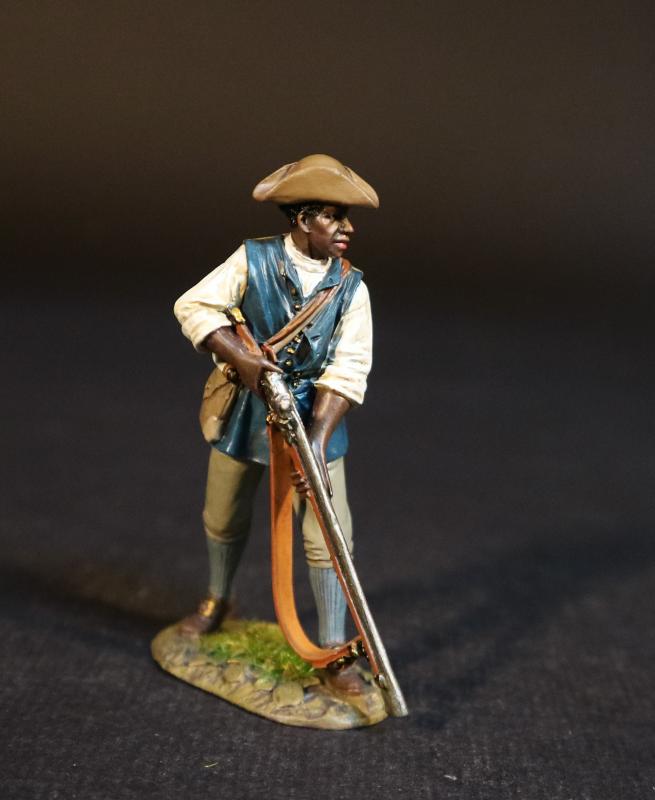Peter Salem,, The American Army, The Assault on the Redoubt at Breeds Hill, The Battle of Bunker Hill, June 17th 1775, AWI, 1775–1783--single figure--ACCEPTING PRE-ORDERS ONLY.
$65.00
Future Release
Add to Wish List Notify Me When Available
Item Number: ABHL-03
Peter Salem,, The American Army, The Assault on the Redoubt at Breeds Hill, The Battle of Bunker Hill, June 17th 1775, AWI, 1775–1783
PETER SALEM
Peter Salem (October 1st, 1750 – August 16th 1816) was an African American from Massachusetts who served as a soldier in the American Revolutionary War. Born into slavery in Framingham, he was freed by his master, Major Lawson Buckminster, to serve in the local militia. He then enlisted in the Continental Army, serving for nearly five years during the war. Afterwards he married and worked as a cane weaver.
A monument was erected to him in the late 19th Century at his grave in Framingham.
Salem took part in the war’s first battles at Concord on April 19th 1775. He was on the roll of Captain Simon Edgell’s militia company from Framingham. On April 24th, he enlisted in Captain Drury’s company of Colonel John Nixon’s 6th Massachusetts Regiment.
Salem fought with this company in the Battle of Bunker Hill. According to Samuel Swett, who chronicled the battle, Salem had mortally wounded Marine’s officer John Pitcairn, although this has been disputed.
He was later to have fought at the battles of Saratoga and Stony Point.
MINUTEMEN
Minutemen were members of the organized New England colonial militia companies trained in weaponry, tactics and military strategies during the American Revolutionary War. They were known for being ready at a minute’s notice, hence the name. They provided a highly mobile, rapidly deployed force that enabled the colonies to respond immediately to military threats.
The minutemen were among the first to fight in the American Revolution. Their teams constituted about a quarter of the entire militia. They were generally younger, more mobile, and were provided with weapons and arms by the local governments.
Boston was the third largest town in North America, and stood on a Peninsula connected to the mainland by a neck just wide enough to cross at high tide. The harbour, large enough to be strategically significant, and central to the town’s economy, was formed by a chain of islands stretching out to sea, guarded by reefs and ledges. North west of Boston was Charlestown, a largely rural peninsula one and a half miles long. Charlestown stood at the south east corner with three hills behind it: Bunker’s Hill, nearest the neck of the Peninsula; Breed’s Hil,l 200 yards above the town; and Moulton’s Hill to the north east.
On the 16th June 1775, 3 detachments from Massachusetts regiments under the command of Colonel William Prescott and engineer Captain Richard Gridley, crossed the Charlestown neck and arrived at Bunker Hill. Captain Richard Gridley and Prescott disagreed as to where they should locate their defense. Some work was performed on Bunker Hill, but Breed’s Hill was closer to Boston and viewed as being more defensible, and they decided to build their primary redoubt there. Prescott and his men began digging a square fortification about 130 feet a side with ditches and earthen walls. The walls of the redoubt were about 6 feet high.
Work began at midnight, and around 4am one of the British warships spotted the earthworks on Breed’s Hill and opened fire. The British command agreed that the works posed a significant threat, but were at this time sufficiently incomplete and isolated to offer a chance of a successful attack.
The original British plan was to bypass the redoubt to the north and capture Bunker’s Hill and the neck of the peninsula, thus isolating the redoubt on Breed’s Hill.
The Americans repulsed two British assaults, with significant British casualties. The British captured the redoubt on their third assault, after the defenders had run out of ammunition. The colonists retreated over Bunker Hill, leaving the British finally in control of the Peninsula.
The battle was a tactical victory for the British, but it proved to be a sobering experience for them; they incurred many more casualties than the Americans had sustained, including many officers. The battle had demonstrated that inexperienced militia were able to stand up to regular army troops in battle. Subsequently, the battle discouraged the British from any further frontal attacks against well defended front lines. American casualties were much fewer, although their losses included General Joseph Warren, and Major Andrew McClary, the final casualty of the battle.
Due to be released in MAY 2025.
